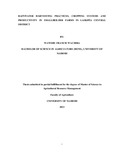Rainwater Harvesting Practices, Cropping Systems And Productivity In Smallholder Farms In Laikipia Central District
Abstract
Over dependence on rainfed agriculture is one of the major problems in Kenya's
agricultural sector. One of the most promising solutions is upgrading rainfed agriculture
through the adoption of rainwater harvesting (RWH) and its management which will
improve water availability for productive purposes. However, what is not clear is the role
of rainwater harvesting on household food security and the returns to the investment in
the water management systems in semi-arid lands. This study evaluated smallholder
farms in Matanya Location which is an area that is prone to drought. The overall
objective was to document rainwater harvesting practices, cropping systems and crop
productivity by smallholder farmers in Laikipia Central District. A survey was carried out
using a structured questionnaire on 100 households. Data obtained was analyzed using
the Statistical Package for Social Scientists (SPSS)
Adoption of rain water harvesting significantly increased crop yields. The average maize
yield in farms with RWH (259 kg/ha) was 14 times more than farms not having RWI-I
which was 18 kg/ha. For vegetable crops, the average yields increased from 4.6 to 9.9
t/ha for spinach, 4.8 to 12.5 t/ha for kales and 4.2 to 10.5 t/ha for garden peas. Though the
vegetable yields were more than double for farms with RWH, it is only in garden peas
that the yield difference was significant (p value less than 0.05). All the 100% farmers
investing in on-farm rainwater storage preferred to irrigate vegetable crops during the dry
season while only 35% irrigated during the rainy season. The crops grown during the dry
season fetched a premium price in the market. Availability of harvested rainwater for
irrigation from water pans had led to a shift from subsistence to commercial farming.
The survey found out that the waterpan capacity ranged from 50 to 100m3 and 50%
suffered from seepage losses. Due to the limited stored water; farmers were shifting from
the use of the furrow water application method to the efficient drip irrigation method .
Farmers adopting the drip irrigation reported higher yields for tomatoes and cabbages.
Few economically well-off farmers were lining their waterpans with UV resistant plastic
material to reduce seepage losses which had been cited as a drawback to the adoption of
this technology. A farmer who invested in the lining of their 100m3 capacity water pan
with UV resistant plastic material and installed the drip system had a net income of Ksh.
74,800 against Ksh. 17,900 for those without the investment. The return to investment
(lining and drip irrigation system) indicted that the farmer could recover the investment
cost within one season. Therefore; on-farm RW storage system was a viable investment
in Matanya. The up-scaling of RWH technologies should therefore be promoted and
supported through various interventions in Laikipia Central District as they were found to
significantly improve agricultural productivity.
Citation
Waweru Francis Wachira (2013). Rainwater Harvesting Practices, Cropping Systems And Productivity In Smallholder Farms In Laikipia Central District. Master of Science in Agricultural Resource ManagementPublisher
University of Nairobi

